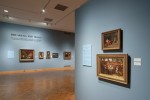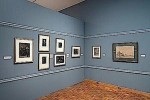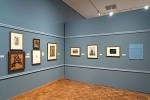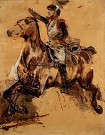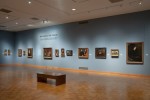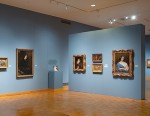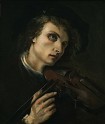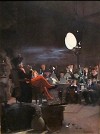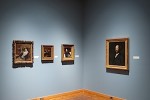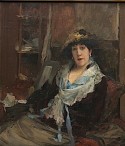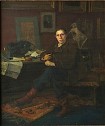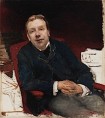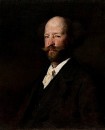The browser will either open the file, download it, or display a dialog.
Breaking the Mold: The Legacy of the Noah L. and Muriel S. Butkin Collection of Nineteenth-Century French Art
The Snite Museum of Art
The University of Notre Dame, Notre Dame, Indiana
September 2–December 2, 2012
Catalogue:
Breaking the Mold: The Legacy of the Noah L. and Muriel S. Butkin Collection of Nineteenth-Century French Art.
Gabriel P. Weisberg with contributions by Kirsten Appleyard, Heather Lemonedes, Sarah J. Sik, and Janet L. Whitmore; research assistance by Yvonne Weisberg.
Notre Dame, Indiana: Snite Museum of Art, University of Notre Dame, 2012.
Distributed by the University of Washington Press.
230 pp.; 95 illustrations, 93 in color; selected bibliography; notes.
$30 (paperback)
ISBN 978-0-9753984-3-2
The recent exhibition of selections from the Butkin collections at the Snite Museum of Art at the University of Notre Dame was something to awaken memories. The 1970s and 1980s were a time of great interest in those lesser-known artists who were referred to with labels such as Academics, Realists, or Naturalists. The artists represented in this exhibition were among them. Perfect subjects for the development of social history and cultural studies. Exhibitions and symposia proliferated. But the excitement faded, perhaps subsumed under the discovery of the nineteenth century, not only on the periphery of Europe, but also around the world.
It is helpful to look at the formation of the collection before considering the exhibition. It was well into the 1970s when Noah and Muriel Butkin discovered this French art of the other nineteenth century and began to collect it. Within a few short years, this Cleveland businessman and his wife amassed a rich and representative collection of diverse works. The Cleveland Museum of Art received a number of fairly large works from the Butkins, finalized as a bequest when Noah Butkin died early in 1980. Over the four years before Noah Butkin’s death, the Snite Museum of Art at the University of Notre Dame received numerous loans of smaller works, many of them oil sketches, which became a gift to the Snite from Noah and Muriel Butkin on her death in 2009. What the Butkins collected has become two collections. Larger works and drawings predominate at the Cleveland Museum while the small oils are in the majority at the Snite Museum.
The Butkins’s search for an area of collecting which they could love, and in which they could make a difference, was enabled by good relationships with museum personnel and gallery directors. Guest curator Gabriel Weisberg, Professor of Art History at the University of Minnesota, remembers this in his introductory essay about the two collections. In the 1970s, he was a curator at the Cleveland Museum. He and Sherman Lee, then the director of the Cleveland Museum, shared their knowledge with the Butkins and enjoyed a mutually beneficial friendship. Another essay pays well-deserved attention to the quiet but close friendship that brought the large collection of small oil paintings to Notre Dame. Kristin Appleyard writes about the relationship between the Butkins and Stephen Spiro, now Emeritus Curator of the Snite.
The reason for this current exhibition at the Snite is to remember and honor the Butkins in their roles as patrons. Weisberg selected a show of eighty pieces, paintings and some drawings, mostly from the Snite collection, but more than a dozen works have been loaned by the Cleveland Museum. Cheryl K. Snay arrived as the new curator of European Painting at the Snite after the show was selected, and had the task of designing and installing a show that would honor the patrons while also creating an effective narrative for the diverse scope of the themes in the collection. It also needed to provide an enriching encounter with art for the general public and serve the university community. Her canny strategy was to make a general outline based on the constantly changing political regimes of nineteenth-century France. A very few succinct and well placed didactics introduced the viewer first to the nature of the collection and subsequently to the pertinent points about political issues and social themes and how they might be reflected in the art.
Although the selection of works prior to 1848 was slender, it was adequate to allow the viewer to separate styles and subject matter and make comparisons. A short, narrow entry corridor took one into the exhibition (fig. 1). Because of the tight size of the corridor, a few small works could make the classical style dominate. François-Xavier Fabre’s small, but tight and authoritative, Marius and the Gaul (1796) hung just above a loose and painterly study for a Roman Triumphal Scene by Joseph-Désiré Court (1820s) (figs. 2 and 3). A general visitor could easily interpret this comparison as a contrast between stern Roman republicanism and the excesses of a decadent society and come away with their positive moral for the day. The works also show the latitude in neoclassical “sketches,” from the clear definition of Fabre to the rambunctious brushwork of Court. The Butkin pieces at the Snite Museum are often referred to as a collection of “sketches.” While not exclusively sketches, the collection is a marvelous demonstration of the variety of approaches to the sketch. Many artists prized the freedom from the tradition of tight finish and the experimental possibilities that were possible in a sketch.
On the opposite wall of the corridor hung another classical subject, Horatio Defending the Bridge (fig. 4). This work of unknown authorship comes from the “Circle of Eugene Delacroix” and stands as the romantic comparison to its neoclassical neighbors. Beyond this entry way, directly across the large gallery ahead, was a sight to jolt one out of the literary historical sensibility of Marius and Horatio (fig. 1). A work by Edward Gabé sets the stage for then contemporary and realistic subjects with its depiction of The Proletariat Seizing the French Throne, painted in the year of the event, 1848 (fig. 5). The layered, diagonal composition is traditional, but the exhausted working class men, pondering their hard won victory, are not. A very different mood has become possible in French art.
For this show, the Snite Museum’s largest special exhibition gallery was designed with an entry, a discrete area for works on paper, and a free-standing wall that broke up the march of small works around an enormous room (fig. 6). Even in an exhibition of smaller works such as the Butkin’s collection, it can be difficult to integrate drawings with paintings. And if the pieces are as dark as Léon Bonvin’s ink and watercolor Kitchen Interior (1856), then a separate setting is necessary. The dark works of the Bonvin brothers, Théodule Ribot, and Emile Bernard play against each other on a wall separate from the pale Jules Dupré landscape to the right (fig. 7). Further to the right in the small gallery containing works on paper, and on the left of the photo, is an example of the complementary nature of the collections given to the Snite and Cleveland museums (fig. 8). Two studies for the same figure in Ernest Meissonier’s 1807, Friedland tangibly demonstrate some of the methods used by the academic artist to understand his task. Noah Butkin gave the vigorous oil on paper sketch of the horseman to the Snite (fig. 9). The large collection of drawings that Muriel Butkin promised the Cleveland Museum included a careful graphite delineation of the rider and his uniform (fig. 10). To have these contrasting pieces presented together is invaluable in the teaching environment of a university.
That the large room was nebulously divided seemed suitable to the diverse selection. However, some themes do predominate at certain moments. Gabé’s weary, realistic mid-century revolutionaries end up surrounded by examples of the contemporaneous taste for religious or romantic works (fig. 11). On the one hand, there is a modèle for a church commission, the Studies for the Chapel of Saint John the Evangelist that Hippolyle Flandrin would execute for the Church of Saint-Séverin in Paris (figs. 12 and 13). A strong contrast to the idea of a design for a church is the mysterious depiction of a monk with a beautiful corpse in A Graveyard Scene by Alexandre Cabanel (fig. 14). Mix this up with a deathbed scene, the severed head of John the Baptist and more. Certainly not relevant to ecclesiastical use, but dead on literary, romantic subject matter.
The melancholic and sentimental predominate on this side of the freestanding wall (fig. 15). The creamy skin and certain slant of the head shared by the women in Isidore Pils’s Young Woman in a Prison Cell;Pierre Puvis de Chavannes’s, Inspiration;and Ary Scheffer’s, Princess Marie de Sayne-Wittgenstein, make these three paintings delightful together. The early Puvis work is a surprise (fig. 16). This highly romantic and sentimental painting, so uncharacteristic of his later work, shows that the younger Puvis has absolute command of academic technique. There is no clue as to what his further development will be. In the twenty-first century, his later work is seen as proto-modernist.
Beyond the freestanding wall and around the rest of the enormous room hung examples of the dizzying variety of themes and techniques possible in the later nineteenth century: portraits and still-lifes, romantic landscapes and Orientalism, historical images and genre paintings, and a strong representation of the work of Jean-Léon Gérôme (fig. 17). He and Théodule Ribot lead in numbers of works selected for the exhibition, five each. Three small works by Gérôme from the Snite collection hang to the left (fig. 18), and a fourth hung near the Puvis. They are basically sketches, but worked with his characteristic care. Their subject matter varies from a study of his own studio to a Spanish bullring to the Sistine Chapel. These small pieces were anchored by an Orientalist exercise that was an early gift by the Butkins to the Cleveland Museum, Gérôme’s larger painting, Leaving the Oasis. Altogether we have both a small survey of Gérôme’s interests and technique, and another example of the complementary nature of the bequests to the two museums.
The two paintings by Jehen-Georges Vibert that hung nearby also represent the collections of both museums (fig. 17). The paintings by Gérôme are of his typical subjects, but neither of these works by Vibert are related to the satirical depictions of the clergy for which he is well known. The Cleveland Museum piece is the Night Class (ca.1881) in which a group of amateurs are working from a costumed model under an arc light (fig. 19). While it documents contemporary studio practice, it also plays at composing with the shadows of artificial light. Just as exceptional among Vibert’s works is Figures on Rocks at the Edge of the Sea (1867) (fig. 20). It is from the Snite collection and was chosen as the signature motif for the catalog and for publicity. A group of figures is clustered together on a rocky outcrop, watching a violent sea under the dramatic light of a storm. Vibert’s popular paintings of clergy were replete with anecdotal humor. This painting is full of mystery. The Night Class relishes obscuring the situation. Both paintings show that Vibert does not need an anecdote, but can captivate the viewer through form and composition.
Ahead in the circumnavigation of the enormous room is a corner of exciting portraits, three by Jules Bastien-Lepage and one by Théodule Ribot, all from around 1880, again representing the collections in Cleveland and at Notre Dame (fig. 21). Bastien-Lepage’s Portrait of Madame Samary of the Odeon was exhibited in 1980 at The Realist Tradition show in Cleveland (fig. 22). Along with his small Portrait of Albert Wolff,itbecame part of a bequest to Cleveland (fig. 23). Bastien-Lepage’s psychological realism, combined with his economy of means, gives living character to these figures and to the next piece, Portrait of the Actor Constant Coquelin l’Aîné, which has been in the collection of the Snite since 1981 (fig. 24). It was not part of the bequest from the Butkins, but was purchased with funds provided by the Butkin Foundation to extend and develop the collection. The portraits exemplify the variety of ways in which the Butkins bestowed their generosity. Mme. Samary was bought and immediately given to enrich a particular exhibition, the Wolff portrait was a personal treasure in their home that was later given to the Cleveland Museum, while the portrait of Coquelin was bought for the Snite from endowment funds given to ensure that the collection would keep growing. The Ribot Portrait of Léon Charly fits this corner not only because of its psychological presence and its date of 1880, but because it is the most recent acquisition, purchased by the Snite Museum in 2011 from funds provided by the Butkin Foundation (fig. 25). Obviously, the collecting has not ended.
Selections from Cleveland dominate a group at the center of the last long wall (fig. 26). Each Cleveland piece played a role in exhibitions that Weisberg organized for the Cleveland Museum while he was curator. François Bonvin’s Attributes of Music was included in Chardin and the Still-Life Tradition in France in 1979 and so was Germain Ribot’s Still Life with Dead Birds and a Basket of Oysters. This latter painting was also included in The Realist Tradition show along with Théodule Ribot’s Singers and François Bonvin’s Portrait of Louison Köhler. All are excellent examples of the influence of the realism of the seventeenth century on painters and taste in the nineteenth century.
This recent exhibition at the Snite provided the occasion for Weisberg to revisit old friends in the Cleveland Museum’s collection, items which he played a role in acquiring for the museum and which enhanced exhibitions he organized. In the mid-1970s, Weisberg was working on a book on François Bonvin and was aided by the Butkins. The book was published in 1977. Related exhibitions at the Cleveland Museum followed, the already mentioned Chardin and the Still-Life Tradition, The Realist Tradition, and a more modest show and catalog by Weisberg of The Drawings and Watercolors of Léon Bonvin. This last included two pieces from Cleveland that are exhibited in the works on paper gallery of this show. Certainly this is an example of the interaction between collectors and curators, which creates the ferment for fresh explorations into the history of art.
The Realist Tradition came in on a wave of interest in Realists and Naturalists. It became part of a larger discussion about definitions and about the role of social history in art history. This display of selections from the Butkins’s collections, including works that were part of that 1980 exhibition, makes us ponder what happened to that interest. The process of uncovering the Realists, the Naturalists, and the Academics gave us back a broader nineteenth century that seemed forgotten after World War II. Information that could be accessed by the undergraduate at that time would be biographical essays, such as Lionello Venturi’s Modern Painters (1947) and Impressionists to Symbolists (1950). The limited number of artists considered, wonderful though they are, became a canon. Slowly alternative approaches were broached. I would remind you of just two. In 1951 Joseph C. Sloane published French Painting Between the Past and the Present in which he studied midcentury criticism and found himself involved with artists outside the usual description of the march to modernism. Twenty years later, in 1971, Albert Boime showed the relationships between the academy and the avant-garde in The Academy & French Painting in the Nineteenth Century. The social protests of the 1950s and 1960s also brought an interest in finding corollaries to then contemporary social concerns in historical art. Academics, Realists, Naturalists, all answered that interest. Now there were new ways for curators to begin to organize and understand some of the legacies in their vaults.
This interest has not gone away, but it has had to take its place in the expanded scope of nineteenth-century art history. It rode in on a wave of social history, which has necessarily expanded to include the nineteenth-century throughout the globe. Some acute observers look at the change in what museums have been exhibiting over the last few decades and find that the type of works that the Butkins were collecting has been accepted and absorbed as an essential part of the narrative. Perhaps there has just been a “quiet revolution” that has expanded our vision.
Because the pieces loaned from the Cleveland Museum for this exhibition are strongly documented in their relation to some of the reasons for the Butkins to collect and to give, they have come in for considerable mention in this review. However, the real import of the catalog of the exhibition is that it makes broadly available for the first time a substantial part of the collection that is housed at the Snite. There was great interest in these small oils after the collecting of the Butkins became well known through The Realist Tradition exhibition. But the collection was unpublished except for scattered bits and pieces. Would a trip to South Bend, Indiana be worthwhile? The catalog makes about a third of the collection at the Snite available in a well-designed volume with excellent color reproductions at a very reasonable price. It fulfills a significant need.
The works selected for the exhibition lean heavily on genre and story, subjects not uncharacteristic of the period or of the collection itself. The catalog does not try to organize the diversity of these small paintings. It would take a much larger number of works to do that effectively. Instead, it is ordered alphabetically by artist. A “selected bibliography” and notes accompany each entry. The authors of the catalog have ranged broadly and inventively in their searches for connections that might open up the circumstances of a painting or, at least, enlighten the viewer about the subject. Some descriptions become lyrically interpretive and speculative. Other entries add enough information to fill a number of pages. For instance, Janet Whitmore deals with the Hippolyte Flandrin studies for St. Séverin by taking her reader beyond the Snite panels to Paris and a comparison with the final paintings as well as the conservation problems that may doom them. Some entries are more limited and serve as a reminder that there are still a lot of interesting projects out there.
The Butkins did not put together a totally Realist or Naturalist collection. They chose broadly from the nineteenth century. Their collection documents many of the great changes of the century as well as the more subtle ones. Their purchases for exhibitions provided a stimulus at the moment it was needed. Their bequest to the Snite Museum has broadened the perspectives of generations of students and visitors. This collection, or this part of the two collections, will have more to say to our understanding of nineteenth century art and life as it is further studied. The catalog makes publicly available a significant part of an enormous collection of small works. Because of this, many more students and scholars will have access to the legacy of Noah and Muriel Butkin.
Marjorie Schreiber Kinsey
mkinsey57[at]sbcglobal.net


